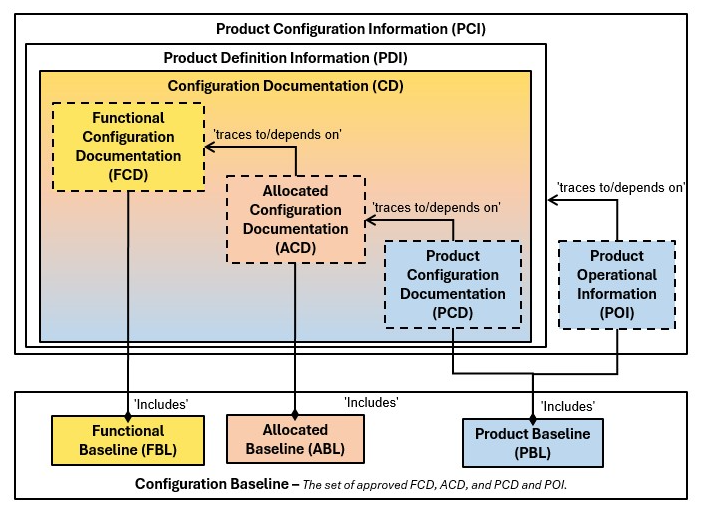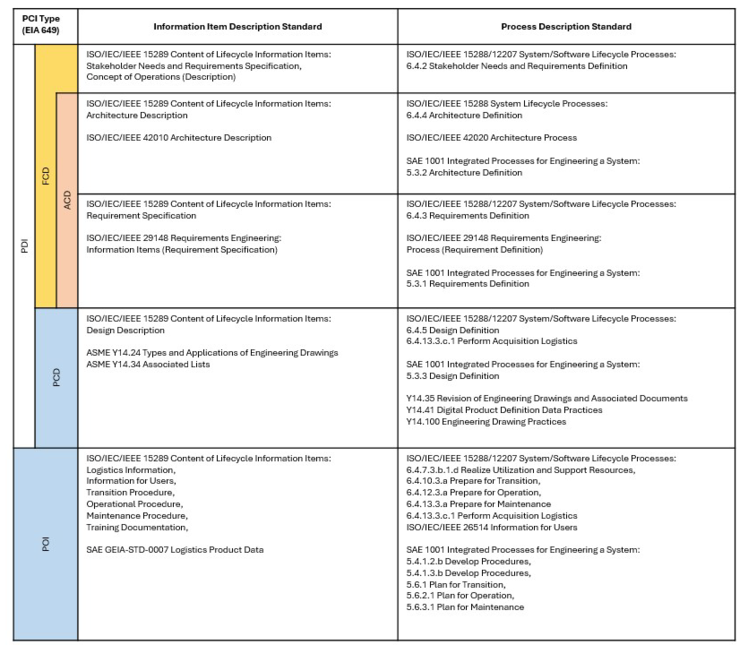Configuration Baselines
In systems engineering, a configuration baseline is a formally approved snapshot of a system's attributes at a specific point in its development. These baselines—such as the functional, allocated, and product baselines—serve as reference points that guide and control subsequent changes to the system. By establishing baselines, teams can ensure consistency, manage complexity, and maintain alignment with requirements throughout the system's life cycle. Configuration baselines are an important concept in the overall disciplines of Configuration Management.
Fundamental Concepts
Process Overview
The information of a Configuration item are assembled into Configuration baselines at certain points after or within in a life cycle stage, as a set of consistent and immutable information that serve as starting points for further changes.
Many types of baselines could be defined depending on the complexity of the system and desire to manage certain types of configuration changes at different levels of the organization. The differences between the information item in each baseline could be by information item type (specifications or descriptions), by information item associated with configuration items at different levels of the system hierarchy, or both.
The next subsection presents three main Configuration Management baselines that are focused on specifications and definition characteristics of the system: Functional Configuration Baseline (FBL), Allocated Configuration Baseline (ABL), and Product Configuration Baseline (PBL). These three formal baselines contain different specifications and description information. They are usually generated in order and aligned with life cycle stage events. They are present in most norms and standards, with some variation in their names, definitions, and scope.
Each of these baselines generally have specific related ‘configuration documentation’: Functional Configuration Documentation (FCD), Allocated Configuration Documentation (ACD), and Product Configuration Documentation (PCD). Configuration baselines and Configuration documentation are crucial in managing the complexity of systems and products, ensuring that all components and configurations are well-documented and understood throughout the lifecycle of the project or product.
Other predefined baselines may exist for the CM of the system, either requested by the applicable normative context, defined in the Configuration Management Plan for specific project’s needs, etc. For example, Mission Objective Baseline which focuses on the purpose, constraints, environment and expected capabilities of the system as planned in [ECSS-M-ST-40C].
Finally, it is important to note that the content of the baselines or related configuration documentation is not necessarily limited to physical documents; the information can also include digital artifacts, such as models, databases, files, and more.
Functional, Allocated and Product baselines and documentation
The following provides definitions of the FBL, ABL and PBL baselines and FCD, ACD and PCD, whose detailed description may differ through various standards.
- Functional baseline represents the approved originating set of performance requirements for the system (functional, interoperability, and interface characteristics) and the verification required to demonstrate the achievement of those specified characteristics.
- Functional Configuration Documentation: includes information on the functional requirements, interface descriptions, and any changes made to the system over time.It serves as a reference for understanding the system’s configuration and for evaluating changes or updates to its functionality. Comparison: the functional baseline acts as a foundational reference point, functional configuration documentation may evolve throughout the life cycle stages as design details are finalized and changes are documented.
- Allocated baseline represents the “allocation” of requirements to the major elements of the system (lower levels Configuration Items). It is the reference point for the functional and performance requirements that have been assigned. It defines what is expected from each component in terms of functionality and performance.
- Allocated Configuration Documentation: it details the specific configurations of the individual system elements that have been derived from the overall system requirements outlined in the allocated baseline. It may include design specifications, performance criteria, and how each system element is configured to meet its designated functions. Comparison: The allocated baseline is a conceptual framework or reference point, while the allocated configuration documentation is a detailed artifact that documents the specifics of individual system elements configurations.
- Product baseline gathers the approved definition and description information resulting from the system definition activities (e.g., system design definition).
- Product Configuration Documentation: This documentation provides comprehensive details about the configuration of a specific product, encompassing its physical and functional characteristics. It typically includes information about the product's design, elements, versions, and any configuration settings that are relevant. It describes how the product should be built and what specifications must be met. Comparison: The product baseline is an established reference for the overall product’s characteristics, while the product configuration documentation contains the specific details needed to implement those characteristics.
Figure 1 hereunder provides a schema of the interconnections between the FBL, ABL and PBL baselines and associated documentation. It may vary according to the normative standard to be applied. In this figure, the terms ‘Product Configuration Information’ and ‘Product Definition Information’ are consistent with SAE-EIA 649C. The organizations may choose other terms.
Figure 2 provides a description of the process and information standards related to product configuration information as illustrated in figure 1.
Elaboration
Configuration Management baselines are related to the artifacts produced and modified throughout the system life cycle. Baselining activities are therefore interfacing with system analysis, system detailed design definition, system realization, system deployment and use, system operation and product and service life management.
Practical Considerations
Pitfalls
Some of the key pitfalls encountered in Configuration baselines are in Table 1.
| Name | Description |
|---|---|
| Shallow Baselines Visibility |
|
| Baselines needs are not tailored adequately |
|
| Lack of Baselines planning and management |
|
| Baselines not used by the stakeholders |
|
| Missing Baselines checks |
|
Good Practices
Some good practices gathered from the references are provided in Table 2 below.
| Name | Description |
|---|---|
| Cross-Functional Baselines |
|
| Baselines over the full lifecycle |
|
| Baselines Planning |
|
| Baselines tooling |
|
| Baselines immutability |
|
References
Works Cited
ISO/IEC/IEEE 15288:2023, Second Edition. Systems and software engineering — System life cycle processes - International Organization for Standardisation / International Electrotechnical Commissions / Institute of Electrical and Electronics Engineers. ISO/IEC/IEEE 15288:2023
INCOSE. 2023. Systems Engineering Handbook: A Guide for System Life Cycle Processes and Activities, version 5.0. Hoboken, NJ, USA: John Wiley and Sons, Inc, ISBN: 978-1-119-81429-0.
ISO 10007, Third Edition. Quality Management Systems – Guidelines for Configuration Management. International Organization for Standardization (ISO), ISO 10007:2017
Blanchard, B.S. and W J. Fabrycky. 2005. Systems Engineering and Analysis, 4th ed. Prentice-hall international series in industrial and systems engineering. Englewood Cliffs, NJ, USA: Prentice-Hall.
IEEE SWEBOK Version 4 2024. Guide to the Software Engineering Body of Knowledge (SWEBOK). Los Alamitos, CA, USA: IEEE Computer Society. Available at: https://www.computer.org/education/bodies-of-knowledge/software-engineering
SEI. 2010. Capability Maturity Model Integrated (CMMI) for Development, version 1.3. Pittsburgh, PA, USA: Software Engineering Institute (SEI)/Carnegie Mellon University (CMU).
Primary References
INCOSE. 2023. Systems Engineering Handbook: A Guide for System Life Cycle Processes and Activities, version 5.0. Hoboken, NJ, USA: John Wiley and Sons, Inc, ISBN: 978-1-119-81429-0.
ISO 10007, Third Edition. Quality Management Systems – Guidelines for Configuration Management. International Organization for Standardization (ISO), ISO 10007:2017
ISO/IEC/IEEE 15288:2023, Second Edition. Systems and software engineering — System life cycle processes - International Organization for Standardisation / International Electrotechnical Commissions / Institute of Electrical and Electronics Engineers. ISO/IEC/IEEE 15288:2023
ANSI/GEIA. 2019. Configuration Management Standard EIA649C. Arlington, VA, USA: American National Standards Institute/Government Electronics & Information Technology Association, EIA649C.
ANSI/GEIA. 2016. Configuration Management Standard Implementation Guide. Arlington, VA, USA: American National Standards Institute/Government Electronics & Information Technology Association, EIA649A.
GEIA. 2022. Data Management. Arlington, VA, USA: Government Electronics & Information Technology Association. GEIA-859B.
Additional References
ISO/IEC/IEEE 16236:2019. Systems and Software Engineering - Life Cycle Processes - Project Management. International Organization for Standardisation / International Electrotechnical Commissions / Institute of Electrical and Electronics Engineers - ISO/IEC/IEEE 16326:2019 (Edition 2)
ISO/IEC/IEEE 15289:2019. Systems and software engineering — Content of life-cycle information items. International Organization for Standardisation / International Electrotechnical Commissions / Institute of Electrical and Electronics Engineers - ISO/IEC/IEEE 15289:2019 (Edition 4)
ISO/IEC/IEEE 24748-1:2024. Systems and software engineering — Life cycle management - Part 1: Guidelines for life cycle management. International Organization for Standardisation / International Electrotechnical Commissions / Institute of Electrical and Electronics Engineers - ISO/IEC/IEEE 24748-1:2024 (Edition 2)
ISO/IEC/IEEE 24748-2 Systems and software engineering — Life Cycle Management – Part 2: Guidelines for the Application of ISO/IEC/IEEE 15288
ISO/IEC/IEEE 24748-2:2024. Systems and software engineering — Life cycle management - Part 2: Guidelines for the application of ISO/IEC/IEEE 15288 (system life cycle processes) - International Organization for Standardisation / International Electrotechnical Commissions / Institute of Electrical and Electronics Engineers - ISO/IEC/IEEE 24748-2:2024 (Edition 2)
ECSS-M-ST-40C Rev.1. 2009. Space project management - Configuration and information management. Noordwijk, The Netherlands: European Cooperation for Space Standardization (ECSS)
ANSI/EEIA. 2020. Configuration Management Requirements for Defense Contracts EIA649_1A. Arlington, VA, USA: Government Electronics & Information Technology Association - EIA649_1A

